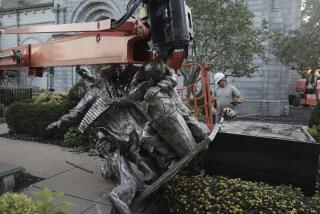‘Dropped Bowl’ makes a mess for officials in Miami : While praised as an exciting work of art, the sculpture has also spawned complaints and a lawsuit.
- Share via
MIAMI — When famed pop artists Claes Oldenburg and Coosje van Bruggen were commissioned five years ago to design a public sculpture for Miami, they promised to come up with something that would symbolize the city.
And they did. “Dropped Bowl With Scattered Slices and Peels” is an immense, complex work of 17 separate pieces made of cast concrete, fiberglass and metal. The sculpture suggests what might happen if a Jack and the Beanstalk-sized giant lost his grip on a pastel-colored bowl of oranges and it shattered all over an acre of downtown Miami.
But three months after the work was given its official debut at the county government complex, Dropped Bowl has come to suggest a lot more about Miami than just its subtropical setting. Within days of its opening, the sculpture’s four computer-operated fountains were ordered shut off because of drought restrictions, and legal action was threatened when a county employee cut his leg after falling into one of the pools that catch the water. Advocates for the disabled charged that the artwork was a hazard to the blind.
Today, the entire area is surrounded by a yellow plastic tape that keeps the public away and gives Dropped Bowl the look of a major crime scene.
The artists are disgusted. “We have never before run into such bureaucratic hassling,” said Van Bruggen from the couple’s New York City home. “Why? I have no idea. We feel this (sculpture) is very beautiful, one of the best we’ve done. But this clash of art and bureaucracy, I’m afraid, is a part of what Miami is about.”
Vivian Donnell Rodriguez, acting director of Dade County’s Art in Public Places program, appreciates the artists’ frustration. And she, too, laments the wrangling that has taken Dropped Bowl out of operation. After all, taxpayers footed the $879,000 cost of the work, and reviews--from citizens and art critics--have been generally favorable.
“Miami got lucky with this one, a clearly understandable pop monument, as big, bright and bold as (the city’s) dreams,” wrote Helen Kohen, art critic for the Miami Herald.
But Rodriguez says it is Dropped Bowl’s complexity, and not Miami’s fractiousness, which has led to problems. “This piece just presents physical conditions that are not the standard things you run into,” she said.
Indeed, Dropped Bowl is an unusual creation, even for a husband and wife team who have built an international reputation for their whimsical, large-scale glorification of the everyday. Among their best known works in this country are “Flashlight” in Las Vegas, “Batcolumn” in Chicago, “Clothespin” in Philadelphia and “Toppling Ladder with Spilling Paint” on the Loyola Law School campus in downtown Los Angeles.
Oldenburg and Van Bruggen agree that Dropped Bowl is their most complex work, a piece “with many viewpoints, slightly disorienting to the viewer, and meant to be discovered bit by bit,” in the words of Van Bruggen.
Among the first to discover Dropped Bowl, and be disoriented by it, were a woman who slipped into one of the pools during the opening festivities, and, four days later, the county employee who cut his leg. Then the directors of two county agencies which represent the physically disabled declared Dropped Bowl a hazard because some of the curved bowl fragments would be almost impossible to detect by a blind pedestrian.
After a series of meetings with the artists and the bureaucrats, Rodriguez says most of the problems keeping Dropped Bowl off limits have been worked out. Oldenburg and Van Bruggen have agreed to the installation of grates over the pools of water, and thousands of transparent warning buttons will be set into the concrete around the sculpture’s upswept fragments.
And, with the beginning of the rainy season, the lifting of water restrictions means the fountains can be switched on.
Despite the brouhaha, Van Bruggen says that she and Oldenburg are satisfied that Dropped Bowl is perfect for Miami. “If we have come up with the right emblem for the city, a universal work of art, then the piece will lead its own life, collecting meaning as it goes on and on,” she explained.
Rodriguez thinks that has already happened. “It’s a beautiful piece, a joyous piece, gorgeous with color and water. And when it’s up and running again, and all those fragments fit together, it will show a potential for unity,” she said. “That could be a metaphor for Miami.”
More to Read
The biggest entertainment stories
Get our big stories about Hollywood, film, television, music, arts, culture and more right in your inbox as soon as they publish.
You may occasionally receive promotional content from the Los Angeles Times.










